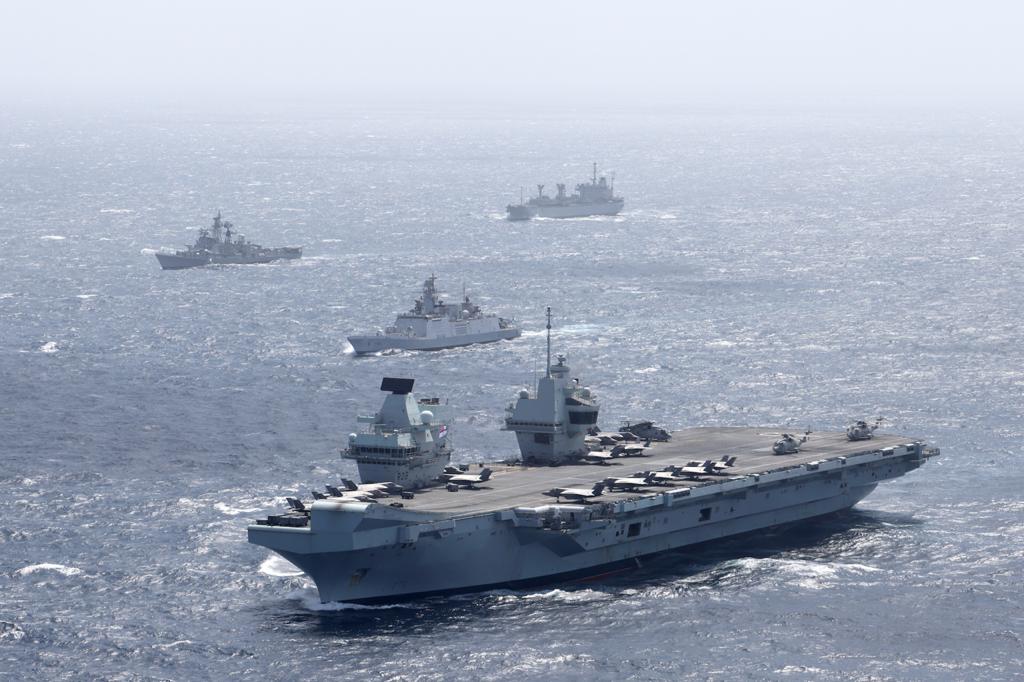
KUALA LUMPUR – The British aircraft carrier HMS Queen Elizabeth (RO8) and its carrier strike group carried out a two-day exercise called Exercise Konkan with the Indian Navy from July 21 to 22 in the Bay of Bengal. The exercise was designed to hone the ability of the two navies to operate together in the maritime domain, according to an Indian Ministry of Defence release. The exercise included anti-submarine warfare, anti-air and anti-surface warfare drills.
The exercise involved the Indian destroyer INS Ranvir (D54) frigate INS Satpura (F48), corvettes INS Kavaratti (P31) and INS Kulish (P63), oiler INS Jyoti (A58) and an unnamed Indian Navy submarine, as well as a P-8I Poseidon aircraft. The U.K. Carrier Strike Group CSG 21 includes Type 23 anti-submarine frigates HMS Richmond (F239) and HMS Kent (F78); Type 45 guided-missile destroyer HMS Defender (D36); Royal Fleet Auxiliary’s RFA Fort Victoria and RFA Tidespring; U.S. destroyer USS The Sullivans (DDG-68); Dutch frigate HNLMS Evertsen (F805); and the nuclear attack boat HMS Artful (S121). U.S. Marine Corps Fighter Attack Squadron (VMFA) 211 is embarked with the air group along with the Royal Air Force’s 617 Squadron “The Dambusters.”
Earlier on July 19, during U.K. Secretary of State for Defence Ben Wallace’s visit to Indo-Pacific Command in Hawaii, Wallace announced via press release that the U.K. Carrier Strike Group would conduct a series of multinational exercises with global allies in the Philippine Sea in August.
“Operating alongside Naval and Air Forces from the United States, Australia, France, Japan, New Zealand and the Republic of Korea, the U.K. Carrier Strike Group will undertake a number of integration exercises designed to build interoperability between like-minded international partners in this globally significant region of the world,” the release stated. “The HMS Queen Elizabeth led Strike Group will operate with a U.S Carrier Strike Group, which combined, will be the largest concentration of F-35 jets anywhere in the world. The Carl Vinson carrier strike group, which is expected to deploy later this summer with an embarked F-35 squadron, is most likely the carrier strike group involved.
The U.K. Carrier Strike Group will also conduct anti-submarine exercises with the U.S. Pacific Fleet involving allied submarines, helicopters and P-8A Maritime Patrol Aircraft, according to the release. The offshore patrol vessels HMS Spey (P234) and HMS Tamar (P233) will deploy to the Indo-Pacific at the end of August 2021. Partners including Australia, Japan and Singapore will support the operations.
Wallace subsequently traveled to Japan for a two-day visit where he met with Japan’s Prime Minister Suga and Defense Minister Kishi. On July 20, in a joint press conference following his meeting with Kishi, Wallace announced elements of the carrier strike group will visit the Japanese ports Sasebo, Okinawa, Kure, Yokosuka, and Maizuru in September. The two Ministers confirmed via a Japan Ministry of Defense press release that, during the CSG21 visit to Japan, Queen Elizabeth will berth at the U.S. naval base in Yokosuka, and that the other escort ships would berth at JMSDF the Japanese Ministry of Self Defense ports Yokosuka, Maizuru and Kure; the U.S. naval base Sasebo; and the White Beach area.





